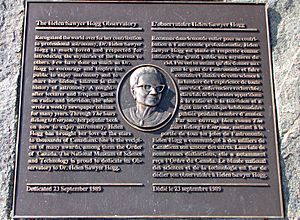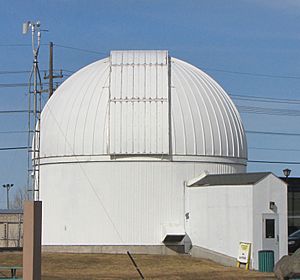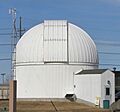Helen Sawyer Hogg facts for kids
Quick facts for kids
Helen Sawyer Hogg
|
|
|---|---|

Plaque to Helen Sawyer Hogg at Canada Science and Technology Museum
|
|
| Born | August 1, 1905 Lowell, Massachusetts, U.S.
|
| Died | January 28, 1993 (aged 87) Richmond Hill, Ontario, Canada
|
| Resting place | Lowell Cemetery, Lowell, Massachusetts |
| Nationality | American Canadian |
| Known for | Globular clusters |
| Spouse(s) |
Frank Scott Hogg
(m. 1930; died 1951)F.E.L.Priestly
(m. 1985; died 1988) |
| Awards | Annie J. Cannon Award in Astronomy (1949) Rittenhouse Medal (1967) Klumpke-Roberts Award (1983) |
| Scientific career | |
| Fields | Astronomy |
| Institutions | David Dunlap Observatory, University of Toronto |
Helen Sawyer Hogg (born August 1, 1905 – died January 28, 1993) was an amazing American-Canadian astronomer. She was a pioneer in studying groups of stars called globular clusters and stars that change brightness, known as variable stars.
Helen was a true leader for women in science. She was the first female president of several important astronomy groups. This was at a time when many universities did not even give science degrees to women. She also helped share her love for astronomy with everyone. She wrote popular astronomy columns like "With the Stars" in the Toronto Star and "Out of Old Books" in the Journal of the Royal Astronomical Society of Canada. People remembered her as a "great scientist and a gracious person" during her sixty-year career.
Contents
Early Life and Education
Helen was born in Lowell, Massachusetts, on August 1, 1905. She was the second daughter of Edward Everett Sawyer and Carrie Douglass Sawyer. Helen was very smart and finished Lowell High School at just 15 years old. She decided to stay one more year before going to Mount Holyoke College in 1922.
Discovering a Passion for Stars
At Mount Holyoke College, Helen almost finished a chemistry degree. But then, in 1925, she took an introductory astronomy class with Dr. Anne Sewell Young. This changed everything! Dr. Sewell took her class to see a solar eclipse of January 24, 1925. A year later, Annie Jump Cannon, a famous astronomer from Harvard University, visited Mount Holyoke. Helen said these moments made her decide to study stars. In 1926, she earned her astronomy degree with high honors.
Graduate Studies at Harvard
After college, Helen got a special scholarship to study at Harvard Observatory in 1926. Dr. Cannon helped her get this opportunity. At Harvard, Helen worked with Dr. Harlow Shapley, who led the astronomy program. Helen worked very hard, measuring the size and brightness of globular clusters. She published many important papers.
Helen earned her master's degree in 1928 and her doctoral degree in 1931. Both degrees were from Radcliffe College. This was because Harvard did not give science degrees to women at that time. Later in her life, Helen received honorary doctoral degrees from six universities in Canada and the U.S. This included Mount Holyoke College and the University of Toronto.
Amazing Scientific Discoveries
While working on her doctoral degree, Helen taught astronomy at Mount Holyoke and Smith College. After graduating, she moved to Victoria, British Columbia. There, she started research at the Dominion Astrophysical Observatory.
Finding New Variable Stars
Helen began taking pictures of variable stars using a large 72-inch telescope. She carefully recorded how the brightness of these stars changed over time. At the Dominion Astrophysical Observatory, Helen found 132 new variable stars in the globular cluster Messier 2. She published this amazing work in astronomy books that are still used today. It's important to know that Helen did all this as a volunteer. The observatory would not offer her a paid job.
Research in Toronto
In 1935, Helen moved to the University of Toronto. Her husband had received a job offer at the David Dunlap Observatory. For her first year, Helen kept taking pictures of globular clusters. She collected thousands of photos. From these photos, she found thousands of new variable stars.
In 1939, she published her book Catalogue of 1116 Variable Stars in Globular Clusters. This was the first of three such books she completed. She was working on a fourth when she passed away. Helen also used the special relationship between the period and brightness of Cepheid variable stars. This relationship, discovered by Henrietta Swan Leavitt, helped her understand the age, size, and structure of our own Milky Way Galaxy.
In the late 1930s, Helen was one of the first astronomers to travel the world for her research. This was because the globular clusters she studied could be seen best from the southern part of the world.
Teaching and Leadership
From 1939 to 1941, Helen returned to America. She served as the president of the American Association of Variable Star Observers. She also led Mount Holyoke's astronomy department for a year. When she came back to the David Dunlap Observatory, she started teaching at the University of Toronto. This happened because many male staff members were away fighting in World War II.
Helen kept her teaching job after the war. She became an assistant professor in 1951, an associate professor in 1955, and a full professor in 1957. She retired in 1976. During her career, Helen published over 200 scientific papers. She became a top expert in astronomy.
Sharing Astronomy with Everyone
Helen did more than just publish her research on variable stars. She also wrote about the history of astronomy in her column "Out of Old Books." This was published in the Journal of the Royal Astronomical Society of Canada. She was also famous for writing her weekly column "With the Stars" for 30 years in the Toronto Star newspaper.
Helen made astronomy popular for everyone. She wrote a book called The Stars Belong to Everyone in 1976. She also had an eight-show TV series about astronomy on Canadian educational television in 1970. She was the first president of the Canadian Astronomical Society. Helen also strongly encouraged other women to study science.
Service and Influence
Helen led several Canadian astronomy and science groups. She was also on the board of directors for Bell Telephone Company of Canada from 1968 to 1978. She directed the National Science Foundation's astronomy program. In this role, she helped choose locations for important observatories. These included the National Radio Astronomy Observatory and Kitt Peak National Observatory in 1955.
In 1960, she became the first woman president of the physical sciences section of the Royal Society of Canada. She was also the first female president of the Royal Canadian Institute (1964–1965).
Personal Life and Family
In 1930, Helen married Frank Scott Hogg, who was also an astronomy student at Harvard. They moved to Victoria, British Columbia, in 1931. Their daughter, Sally, was born in June 1932. Helen was able to keep doing her night observations. She would bring her sleeping baby daughter with her to the observatory in a basket! The observatory's director, Dr. J.S. Plaskett, was very supportive. He gave Helen money to hire a full-time housekeeper for a year. This helped her continue her important research.
In 1935, the family moved to Ontario. They worked at the University of Toronto's David Dunlap Observatory. Their second child, David, was born in January 1936. Their third child, James, was born in September 1937. Sadly, Frank died in 1951 from a heart attack. Helen took on many of his work duties while also raising their three children. In 1985, Helen married F.E.L. Priestley, a professor from the University of Toronto. He passed away in 1988.
Helen Sawyer Hogg died from a heart attack on January 28, 1993, in Richmond Hill, Ontario. An article about her amazing contributions to physics and astronomy was published in the Journal of the Royal Astronomical Society of Canada.
Awards and Honours
Awards
- Annie Jump Cannon Award in Astronomy from the American Astronomical Society in 1949.
- Klumpke-Roberts Award from the Astronomical Society of the Pacific in 1984.
- Sandford Fleming Award from the Royal Canadian Institute in 1985.
- Rittenhouse Astronomical Society Silver Medal Award in 1967.
- The Centennial Medal of Canada in 1967.
Honours and Dedications
- She was made an Officer of the Order of Canada in 1968. This is one of the highest honours in the country. She was promoted to Companion in 1976.
- The asteroid 2917 Sawyer Hogg is named after her.
- The National Museum of Science in Ottawa, Ontario, has a dedication to Helen.
- A telescope at the University of Toronto's Southern University observatory in Chile is also dedicated to her.
- In 2004, Helen was added to the Canadian Science and Engineering Hall of Fame.
- The University of Waterloo in Ontario, Canada, offers the Helen Sawyer Hogg scholarship in Astronomy. This helps students who want to study astronomy in graduate school.
Images for kids
See also
 In Spanish: Helen Sawyer Hogg para niños
In Spanish: Helen Sawyer Hogg para niños




